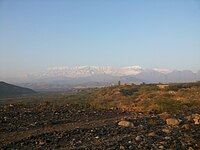
Photo from wikipedia
Mentha is an aromatic plant used since antiquity for its pharmaceutical virtues. The climate of Saudi Arabia favors the growth of aromatic plants including Mentha suaveolens L. The aim of… Click to show full abstract
Mentha is an aromatic plant used since antiquity for its pharmaceutical virtues. The climate of Saudi Arabia favors the growth of aromatic plants including Mentha suaveolens L. The aim of this study is to analyze the volatile oils of different parts of fresh and dried Mentha suaveolens L. grown in Saudi Arabia (Aljouf area) using Gas Chromatography/Mass Spectrometry (GC/MS) and Gas Chromatography Flame Ionization Detector (GC/FID) techniques, to recognize the effect of drying on chemical composition, then to evaluate the antioxidant and antifungal activities of different extracts. In total, 118 compounds were identified via GC/MS and GC/FID, in which carvone is the main volatile constituent (stems, leaves, whole plant 45–64%). This investigation deduces that Mentha belonged to the carvone chemotype. Then, the analysis of non-volatile constituents of fresh and dried Mentha was performed by HPLC. The main phenolic compound of fresh and dried Mentha for different parts was rosmarinic acid (ranging from 28,002.5 to 6558 µg/g). The ethanolic extract of fresh stem showed the highest antifungal activity (53% inhibition) compared with miconazole (60% inhibition) but the ethanoic extract of dry stem showed no activity. Additionally, all ethanolic extracts, whether for fresh or dry Mentha, have antioxidant activity more than 90% while the antioxidant activity of whole plant volatile oil is equal to 53.33%. This research shows that M. suaveolens L. could be applied to manufacture natural antioxidants, antifungal, and flavoring agents.
Journal Title: Molecules
Year Published: 2022
Link to full text (if available)
Share on Social Media: Sign Up to like & get
recommendations!